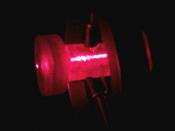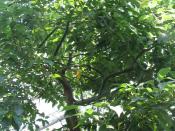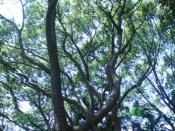Oetomo, 6
Experiment 7: Oxidation of Isoborneol
Raw Data
A & C: Measuring the Optical Rotation of Camphor Samples and Camphor Obtained from Oxidation of Isoborneol
Samples | Path Length (dm) | Concentration (gr/100 mL) | Optical Rotation (ð) | |||
#1 | #2 | #3 | Ave | |||
Solvent (achiral) | 1.97 | - | -1.5 | -1.5 | - | -1.5 |
Camphor from camphor tree | 1.97 | 20.83 | 16.2 | 16.3 | 16.3 | 16.3 |
Camphor from Cranensum darlimi | 1.98 | 19.65 | 10.0 | 9.7 | 9.8 | 9.8 |
Logan's Lumber cat. #3921-5G | 1.97 | 19.67 | -1.7 | -1.7 | -1.5 | -1.6 |
DeSouza Amazonia cat. #C2418-5G | 1.96 | 19.59 | 10.6 | 10.6 | 10.5 | 10.6 |
Sample from oxidation of isoborneol from Hermanium siamium | 1.97 | 20.96 | -12.6 | -12.8 | -12.7 | -12.7 |
Table 1: Optical Rotations of Ethanol as Solvent Measured Twice Independently and Samples Measured Three Times Independently and Their Average (Ave) in Polarimeter.
B: Oxidation of Isoborneol
Components | Volume (mL) | Density (gr/mL) | Mass (gr) | Molecular Weight (gr/mol) | Moles (mmol) |
Isoborneol | - | - | 0.233 | 154.25 | 1.51 |
Glacial Acetic Acid | 0.3 | 1.049 | - | 60.05 | 5.24 |
5% Sodium Hypochlorite (Bleach) | 3.0 | 1.097 | - | 74.44 | 2.21 |
Acetone | 1.0 | 0.791 | - | 58.08 | 13.6 |
Table 2: Moles of Isoborneol Calculated from Mass[1] and Moles of Glacial Acetic
Acid, 5% Sodium Hypochlorite, and Acetone Calculated from Volumes[2].
Mass of Solid (gr) | 1.122 |
Table 3: Mass of Solid Camphor (Product of Oxidation of Isoborneol). Measured after extracted with 2.0 mL dichloromethane twice, washed sequentially with 2.0 mL saturated aqueous sodium bicarbonate, 2.0 mL 5% aqueous sodium bisulfite, and 2.0 mL water, dried with anhydrous CaCl2, and boiled with 0.5 mL dichloromethane.
Calculations
Moles of Components from Mass
The number of moles of the components used in the oxidation reaction was calculated from mass with the formula:
where: n = moles (mmol)
m = mass (gr)
MW = molecular weight (gr/mol) and: 1 mol = 1000 mmol
For example the isoborneol:
Moles of Components from Volume
The number of moles of the components used in the oxidation reaction was calculated from volume with the formula:
where: n = moles (mmol)
ÃÂ = density (gr/mL)
V = volume (mL)
MW = molecular weight (gr/mol) and: 1 mol = 1000 mmol
For example the acetone:
Percent Yield
The theoretical yield of the oxidation reaction should be 1.51 mmol of camphor, equal to 0.230 gr of camphor (from molecular weight of 152.23 gr/mol).
Calculation | Result | |
Percent Yield | 488% |
Table 4: Calculation of Percent Yield of Solid Camphor from Oxidation of Isoborneol.
Specific Optical Rotation
Specific optical rotations of the samples could be calculated by the formula:
where: = specific optical rotation
= measured optical rotation
l = cell length (dm)
c = concentration in gr/100 mL
The average of the measured optical rotation in the raw data was calibrated using the measured optical rotation of just solvent (-1.5ð), which theoretically should be 0, by:
Calibrated = Measured - Optical Rotation of Solvent
Samples | Path Length (dm) | Concentration (gr/100 mL) | Optical Rotation (ð) | Specific Optical Rotation | |
Measured | Calibrated | ||||
Camphor from camphor tree | 1.97 | 20.83 | 16.3 | 17.8 | 43.4 |
Camphor from Cranensum darlimi | 1.98 | 19.65 | 9.8 | 11.3 | 29.0 |
Logan's Lumber cat. #3921-5G | 1.97 | 19.67 | -1.6 | -0.1 | -0.3 |
DeSouza Amazonia cat. #C2418-5G | 1.96 | 19.59 | 10.6 | 12.1 | 31.5 |
Sample from oxidation of isoborneol from Hermanium siamium | 1.97 | 20.96 | -12.7 | -11.2 | -27.1 |
Table 5: Calculation of Specific Optical Rotation of Samples.
Enantiomeric Excess
The reported specific optical rotation of (+)-camphor isolated from camphor tree (Cinnamomum camphora), +43.4 (c 20.83, EtOH) and of (-)-camphor, -43.4 (c 20.83, EtOH). Enantiomeric excess of the samples could then be calculated by the formula:
where: e.e. = enantiomeric excess
= specific optical rotation from observation
= specific optical rotation from reference
Samples | Specific Optical Rotation | Enantiomeric Excess | |
Type | Value (%) | ||
Camphor from Cranensum darlimi | 29.0 | (+) | 67 |
Logan's Lumber cat. #3921-5G | -0.3 | (-) | 1 |
DeSouza Amazonia cat. #C2418-5G | 31.5 | (+) | 73 |
Sample from oxidation of isoborneol from Hermanium siamium | -27.1 | (-) | 63 |
Table 6: Calculation of Enantiomeric Excess of Samples.
Ratio of Enantiomers in Mixture
Ratio of the enantiomers in the mixture could be determined from the relation of the enantiomeric excess from the relation:
where: e.e. = enantiomeric excess
A = amount of one enantiomer
B = amount of the other enantiomer
and: A > B
Solving for A in a basis of A + B = 100% gives:
in %
Samples | Enantiomeric Excess | Ratio (%) | ||
Type | Value | (+) | (-) | |
Camphor from Cranensum darlimi | (+) | 67 | 83 | 17 |
Logan's Lumber cat. #3921-5G | (-) | 1 | 50 | 50 |
DeSouza Amazonia cat. #C2418-5G | (+) | 73 | 86 | 14 |
Sample from oxidation of isoborneol from Hermanium siamium | (-) | 63 | 19 | 81 |
Table 7: Calculation of Percent Ratio of Enantiomers in Mixture from Enantiomeric Excess.
Discussion
Part A & C: Measuring the Optical Rotation of Camphor Samples
The samples were measured for the optical rotations using a polarimeter. The polarimeter reading showed -1.5ð rotation with just the achiral solvent, ethanol, which theoretically should be 0ð. Thus, this value was used to calibrate the values measured for other samples, i.e. in Table 5, the calibrated optical rotation of camphor from camphor tree (Cinnamomum camphora) was 17.8ð from 16.3ð. Then, the specific optical rotation could be calculated using the formula from Calculations - Specific Optical Rotation which for camphor from camphor tree turned out to be +43.4 (c 20.83, EtOH). It was assumed that only the (+)-enantiomer of camphor is isolated from the camphor tree so the value was assigned as in the formula to calculate enantiomeric excess (see Calculations - Enantiomeric Excess). The enantiomeric excess of the (+)-enantiomer of camphor from Cranensum darlimi was calculated as 67% in Table 6. From the enantiomeric excess, the ratio of the two enantiomers in the mixture could be determined with the formula in Calculations - Ratio of Enantiomers in Mixture. Camphor from Cranensum darlimi was consisted of 83% of the (+)-enantiomer and 17% of the (-)-enantiomer in Table 7.
All of the measurements from the polarimeter were taken 3 times independently to ensure the accuracy of reading. In calculating the enantiomeric excess, the path length and the concentration of all the samples were assumed to be equal because their standard deviations were very low (0.00707 dm and 0.691 gr/100 mL respectively).
The ratio of the (+)-enantiomer of camphor in the mixture extracted from Cranensum darlimi by Wang-Hai and Co. was lower than 90% so it is not justified to purchase and resell this product. The other candidate, camphor from oxidation of isoborneol from Hermanium siamium had 81% of the (-)-enantiomer with the yield to be discussed in the next part.
The purity of the sample from Logan's Lumber cat. #3921-5G was supported by the 50-50 ratio showed in Table 7, which means the mixture is racemic camphor. The purity of the sample from DeSouza Amazonia cat. #C2418-5G however was not too convincing because the ratio of enantiomers was not close to 50-50 and it was showed that it has 73% enantiomeric excess of the (+)-enantiomer.
Oetomo, 1
Oetomo, 2
[1] Refer to Calculations - Moles of Components from Mass
[2] Refer to Calculations - Moles of Components from Volume
Part B: Oxidation of Isoborneol
Camphor was obtained from oxidation of 1.51 mmol (0.233 gr) of isoborneol obtained from Hermanium siamium. An environmentally friendly way to achieve this reaction was by using 3.0 mL bleach which contains 5% sodium hypochlorite (NaOCl, 2.21 mmol) and 0.3 mL glacial acetic acid (5.24 mmol) which facilitated the reaction by converting the sodium hypochlorite to hypochlorous acid (HOCl) which was the active oxidizing agent instead of using chromic acid as the waste could be corrosive and generally harmful. The reaction between sodium hypochlorite and acetic acid are given as: NaOCl + CH3COOH HOCl + CH3COONa. There is proof that an alkyl hypochlorite intermediate is produced, which then gives the product via an E2 elimination.
Figure 1: Schematic of Oxidation of Isoborneol into Camphor through Alkyl Hypochlorite Intermediate[3].
The reaction was carried out in 1.0 mL acetone (13.6 mmol) at controlled temperature of 45ðC and the addition of bleach was done dropwise over 35 minutes. There was more sodium hypochlorite added to ensure that the reaction reached completion, or to simply say isoborneol was the limiting reagent.
Two portions of 2.0 mL dichloromethane were used to extract the product of the oxidation. Then, 2.0 mL saturated, aqueous sodium bicarbonate was then used to wash the extract to separate the organic layer from the aqueous solution. After that, excess HOCl that remains after the reaction was destroyed by 2.0 mL 5% aqueous sodium bisulfite solution (reducing agent). Finally, 2.0 mL of water was used to wash the solution to get rid of any components that dissolves in aqueous solution. The organic layer was dried with anhydrous CaCl2 before transferred to a dry tared 10-mL E-flask and added with 0.5 mL dichloromethane used to rinse the drying agent. The mixture was heated to gentle boiling on a heating plate with boiling stick inside to give camphor as a solid. The solid product mass was recorded to be 1.122 gr which is 488% of the theoretical yield of 1.51 mmol of camphor (0.230 gr). This high yield is of course impossible and the error related here was because the solvent was not completely evaporated before the final mass measurement because of lack of time in the experiment. However, the camphor has 63% enantiomeric excess for the (-)-enantiomer which made it unsuitable for Logan's Lumber who wanted the (+)-enantiomer to have higher ratio even if the reaction yield is greater than 80%.
[3] John H. Penn from Department of Chemistry of West Virginia University, Morgantown, WV. Adapted from Pavia, D.L.; Lampman, G.M.; Kriz, G.S.; Engel, R.G. Introduction to Organic Laboratory Techniques,
3rd Edition, 1990, Saunders College Publishing, New York, NY


